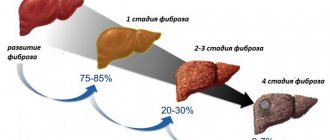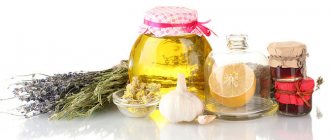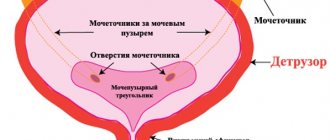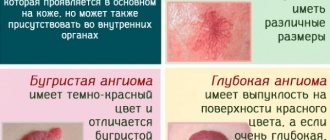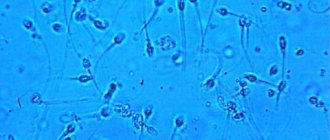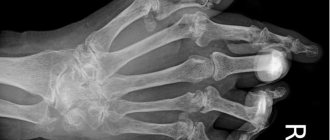Bladder stones: what are they, types
The course and manifestations of urolithiasis are influenced by the size of the stones, their number and composition. More often, doctors diagnose calcium stones in the bladder in women (80%). These are dangerous and dense formations (a calcified foreign body on the surface of which calcium salts collect), difficult to remove.
Taking into account the chemical composition, the following stones are distinguished:
- Oxalate. Formations are brown in color, with an uneven surface. They easily disrupt the integrity of the mucous membrane, due to which urination is accompanied by pain and blood. Oxalate stones contain oxalic acid salt.
- Phosphate. Gray and weakly durable formations containing salt and phosphorus. They appear if material metabolism is disrupted in the human body. This is evidenced by light-colored flakes in the urine, pain in the lower abdomen and impaired urination.
- Urate. The stones have a smooth surface, they do not violate the integrity of the mucous membrane, and are formed due to the low water content in the human body. A urine test can determine the formation of urate stones.
- Struvite. They are formed as a result of the negative impact of pathogenic bacteria when ammonium, carbonate, phosphate and magnesium precipitation falls.
- Cystine. Crystalline stones with six edges, the formation of which is facilitated by congenital metabolic disorders. The examination results will show increased cystine.
- Mixed. Concretions with a layered pattern containing different salts.
Women are more likely to go to the hospital with urolithiasis than men. This is explained by the physiological structure of their body and the chemical composition of urine.
Features of urolithiasis in men
KSD is characterized by the formation of stones that are localized in the renal pelvis, ureter, bladder or urethra. Urolithiasis in men is characterized by multifactorial development, a varied clinical picture, as well as the risk of serious complications requiring surgical intervention.
Classification
The disease can be differentiated according to several criteria:
- based on the anatomical location of the stones - renal calyces and pelvis, ureters, bladder and urethra;
- according to the number of stones - single, multiple;
- depending on the causes - primary (there are no signs of previous pathology), as well as secondary (clinical symptoms of the disease that led to nephrolithiasis are present);
- by the nature of the stones - oxalates (based on oxalic acid), urates (urate), phosphates, protein (cystine), mixed.
The ICD classification in men also includes a division into diseases with and without complications.
Reasons for development
Nephrolithiasis is a multifactorial disease, which is based on a breakdown of metabolism in the body.
The most common causes leading to urolithiasis in men:
- prostate adenoma is a benign neoplasm that creates conditions for stagnation of urine and is a prerequisite for the formation of stones;
- anatomical and physiological features - the weak elasticity of the muscular layer of the ureter in men plays a role, as well as the fact that it is thinner and longer than the female one;
- abnormalities in the development of the urinary system, inflammatory processes (prostatitis, urethritis);
- heredity;
- Men are characterized by an excess of protein products in their diet;
- low fluid intake, uncontrolled medication intake, physical inactivity, dry climate, hypermineralization of drinking water.
The reasons for the formation of stones in men are disorders in other body systems - hepatitis, pancreatitis, cholelithiasis, colitis develop.
Pathogenesis of urolithiasis
Urolithiasis is based on complex biochemical processes. The core or matrix for organizing the stone is exfoliated epithelial cells in inflammatory diseases. The abundance of salts in the urine, which are no longer able to dissolve, leads to the precipitation of compounds.
There is also a colloidal hypothesis for the formation of stones. According to it, urine is a complex biological fluid, saturated with minerals and protein substances that are in chemical equilibrium with each other. This relationship ensures that the salts are kept in a dissolved state. A metabolic failure in the body disrupts the balance between proteins and minerals, which triggers the process of stone formation.
Obstruction to the outflow of urine, which occurs due to various reasons (tumors, narrowing, developmental abnormalities), delays the passage of sand and microliths with urine.
Causes of bladder stones in women
Discomfort and unpleasant symptoms during urination should alert you; these may be the first manifestations of urolithiasis.
Provoking reasons are:
- heredity;
- poor nutrition (frequent consumption of foods that contain uric and oxalic acid, eating spicy, sour and bitter foods);
- inflammatory process in the bladder, trauma;
- insufficient fluid intake;
- abnormal structure of the urinary tract;
- endocrine diseases leading to calcium metabolism failure;
- poor physical activity;
- diseases of the kidneys and digestive system (ulcers, gastritis, colitis);
- disturbance of material metabolism;
- foreign body;
- spinal injury, osteoporosis.
Bladder stones (symptoms in women are provoked by numerous factors) occur under the influence of geographical and climatic influences. During the heat, sweating increases and the concentration of salts in the bladder increases. Hard water promotes the formation of stones.
Bladder stones in pregnant women
Stones in a woman who is carrying a child are formed due to the following reasons:
- the presence of sand or small formations before fertilization has occurred;
- disruption of metabolic processes as a result of low mobility of a pregnant woman;
- the appearance of edema due to double load on the kidneys (urine concentration increases, the expectant mother consumes less fluid);
- abuse of canned foods and semi-finished products, insufficient amounts of fruits and vegetables in the diet.
The first symptoms of bladder stones appear more often in late pregnancy in women. This is due to the deposition of calcium, which is removed from the body more slowly during this period.
Diagnostic methods
Identification of urolithiasis is a complex process that involves a number of diagnostic procedures. All of them together make it possible to accurately determine the presence of stones, their location, type and size, as well as identify possible concomitant pathologies.
Examination stages:
- Finding out the patient’s medical history, drawing up a diagnostic picture. The doctor interviews his patient about his condition, symptoms, and the presence of possible endocrine and metabolic disorders. He needs to find out what climate the patient lives in, where, by whom and under what conditions he works, how he eats, whether he has hormonal disorders and pathologies of internal organs (for example, prostate hyperplasia).
- Urine analysis in the laboratory. With its help, a specialist can assess the condition of the patient’s urinary tract and determine the presence of any pathology (by the presence of marker substances and specific bodies, for example, bacteria, in urine).
- Blood analysis. It is carried out if the diagnosis of a urine sample reveals a significant number of leukocytes. A blood test will refute or confirm possible infectious complications.
Instrumental examination is of great importance. Its methods make it possible to localize and see uroliths, and provide a medical assessment of the condition of the kidneys. Instrumental techniques include: microwave radiothermometry, ultrasound diagnostics, MRI.
Symptoms of bladder stones in women
Signs of the disease are conventionally divided into 2 types.
General symptoms:
- Urination is intermittent, but is restored when changing body position.
Symptoms of bladder stones - Intense pain in the bladder and lower abdomen. It gets worse when moving or urinating. Pain is also felt in the perineum and external genitalia.
- Urine with bloody impurities. Stones damage the mucous membrane with their sharp edges.
- When urinating, a woman feels a strong burning sensation. At night she is disturbed by false urges, preventing her from sleeping. The phenomenon is called dysuria.
- Cloudy green urine indicates the development of a bacterial infection.
- Severe pain in the lumbar region when the stone moves into the kidney from the ureter.
A complete lack of urination requires urgent medical attention to avoid serious complications (a stone may cut into the urethra, in which case it will need to be removed surgically). Local symptoms of the disease are weakness, joint and headache, high fever, poor appetite.
Treatment
What to do with urolithiasis? The choice of treatment for urolithiasis in men largely depends on the symptoms demonstrated: the clinical picture determines the therapeutic tactics.
According to the severity of the condition and the severity of the manifestations of the pathology, measures are divided into:
- emergency therapy;
- planned events.
Emergency therapy is aimed at quickly relieving renal colic and eliminating spasm. For this, the patient is given antispasmodics. In addition to the anesthesia itself, these drugs help remove the urolith out.
Among the well-proven drugs of this kind:
- No-shpa;
- Baralgin;
- Papaverine.
In acute conditions, specialists prefer to administer antispasmodics to the patient intravenously to achieve the desired effect as quickly as possible.
Planned measures are aimed at ridding the patient of uroliths and eliminating the causes of stone formation.
These include:
- conservative methods;
- instrumental influence;
- surgical intervention.
Treatment with medications is designed to improve the flow of urine, relieve inflammation, destroy and remove stones. So, antibiotics are prescribed for complications when a bacterial infection develops in the background. A course is required after surgical or instrumental removal.
The disintegration of stones is facilitated by agents that change the acid-base balance of urine. Thanks to this, the stones dissolve and an obstacle is created to the formation of new ones. Such drugs are especially effective in combination with diuretics.
Among such medications:
- Uralit-U;
- Marelin.
The diuretic effect helps to pass the stone.
Instrumental therapy (lithotripsy) involves the destruction and removal of formations by contact or at a distance, using special instruments and devices. The nodules are destroyed under the influence of ultrasound, electromagnetic and electrohydraulic waves, and the remainder will come out on its own.
The procedures are performed both by directly inserting the instrument (through the urethra) to the site of exposure, and remotely. This is how large fractions are usually destroyed, breaking them into small fragments that come out naturally.
In difficult cases, when there are no other options to rid the patient of the stone or the situation requires immediate removal of the obstruction to urine drainage, surgery is resorted to.
Previously, doctors performed classic abdominal operations, when the peritoneum was opened and the surgeon worked on open organs. But today, even in difficult situations, minimally invasive interventions are mainly carried out, when instruments are inserted through small punctures in the tissue, and the process is controlled by an endoscope with a camera and a light source inserted through the same hole.
Diagnostics
Bladder stones (symptoms in women require medical examination to confirm the diagnosis) can be determined by the following tests:
- Analysis of urine. The results allow you to determine the extent of inflammation, the presence of salt and the level of red blood cells.
- Ultrasound examination (ultrasound). The doctor examines the bladder and kidneys to look for stones. Notes the size, structure and shape of organs. Using an ultrasound, you can see stones that an x-ray will not show.
- Cystoscopy. The examination allows you to determine the size, as well as determine the surface, color and mobility of the stone.
- Radiography. The organs of the urinary system are examined to identify radiopaque stones.
In some situations, additional laboratory examinations are required (urography, retrograde cystography, computed tomography (CT), uroflowmetry).
Why do stones appear?
Doctors divide all the reasons for the formation of stones in the urinary tract into two large categories:
- Etiological.
- Pathogenic in nature.
The first category includes disorders caused by exposure to various factors, both external and internal.
All of them in one way or another negatively affect the tissues and organs of the urinary system:
- nephrosis-like syndrome:
- congenital developmental pathologies;
- acquired problems (prostate adenoma, kidney displacement, trauma, etc.);
- tubulopathy.
Tubulopathy is a disease that develops as a result of a metabolic failure in which the renal tubules undergo enzymatic changes.
This problem is caused by a number of negative factors, exposure to many of them is more common in men:
- poor quality water;
- smoking;
- work in hazardous industries (chemical industry, for example);
- improper/irregular diet leading to chronic gastrointestinal disorders;
- intense physical work at high temperatures;
- inactivity;
- living in hot countries, which can be difficult for an unadapted organism, etc.
For example, a long stay in the heat, during which a person drinks hard water to quench thirst, leads to an increase in the content of salt compounds in urine. They, in turn, are deposited into stones.
Anatomy also plays a very important role: the structure of the urinary tract and its anomalies have a significant influence on the development of pathology. Many men have to deal with a disease such as prostate hyperplasia; increasing in size, the organ impairs the passage of urine, leading to an increase in the level of salts in urine. In addition, stagnation processes begin, which can potentially cause inflammation.
Pathogenic factors are the negative effects of bacterial microflora and other processes in the body that trigger stone formation. For example, this is the above-mentioned inflammation of the organs, which occurs due to a bacterial infection or under the influence of other factors.
Prevention of bladder stones in women
You can prevent the formation of stones by simply following simple rules.
Recommendations for the prevention of urolithiasis:
- Lead an active lifestyle and play sports.
- Eliminate disturbances in the functioning of the genitourinary system.
- Treat chronic diseases in a timely manner.
- Move more at work if it is sedentary. Change positions, take more walks during breaks.
- After surgery, patients are recommended to engage in therapeutic exercises, adhering to medical prescriptions.
- Maintain proper nutrition. Reduce consumption of fatty, salty and sour foods.
- Patients after treatment for urolithiasis should adhere to a special diet. The diet is adjusted by a nutritionist, taking into account the patient’s condition and his individual characteristics.
- Periodically undergo a comprehensive examination (donate blood and urine every 3 months) to monitor calcium and vitamin D levels, and also visit a urologist.
- After an illness, it is necessary to undergo an ultrasound examination every 6 months.
These simple recommendations from specialists are good prevention against the formation of bladder stones. They reduce the risk of their formation and additionally help get rid of disorders in the genitourinary system.
Prognosis and prevention
Preventing urolithiasis is a difficult but feasible task for a man. There is primary (directed against the occurrence of urolithiasis) and secondary (recurrence of the disease) prevention.
The first place in preventing the formation of stones in men is strict adherence to a proper diet. The diet should be varied, and the drinking regime should include 1.5–2 liters of clean water per day.
It is important to follow all the advice and prescriptions prescribed by the urologist, and systematically take medications to dissolve stones. A man is recommended for a sanatorium-resort balneological holiday (mineral water therapy) - Essentuki, Kislovodsk, Borjomi and others.
The prognosis for urolithiasis for men is favorable with timely diagnosis and adequate treatment. However, with the development of complications and inadequate medical care, irreversible renal dysfunction (CRF) and sometimes death can occur.
Treatment methods for bladder stones in women
Bladder stones (symptoms in women are treated conservatively or surgically) are helped to dissolve and remove medications. The therapy is selected by the doctor (therapist, urologist), taking into account the size and location of the stones, their mobility and shape. Having determined their composition, the patient is prescribed a special diet. In difficult situations, surgery is indicated for patients.
Diet
Proper nutrition during the treatment of urolithiasis is an integral part. Nutritionists recommend eating a balanced and nutritious diet, adding more foods to your diet that contain microelements and vitamins. The diet also includes drinking plenty of fluids. In the absence of hypertension, it is recommended to drink up to 2 liters throughout the day.
The patient's diet during bladder therapy excludes:
- for calcium and phosphorus stones - dairy products, meat, fish;
- for urate stones - legumes, strong tea, spicy cheese, liver, fatty meat, alcoholic beverages, offal and fats of animal origin;
- for oxalate - sorrel, chocolate, tomatoes, legumes.
Dietary food completely excludes confectionery, spinach, tomatoes, asparagus, and radishes. To reduce the load on your kidneys, you should reduce your salt intake. It is recommended to add foods to your diet that reduce or prevent the accumulation of oxalic acid. It promotes the formation of chemical compounds (oscalates).
During treatment you need to use diuretic products:
- fruits, vegetables, berries (currants, lingonberries, lemon, watermelon, pears, cherries);
- porridge and cereals (rice, buckwheat, oats, barley, millet);
- bakery products for the preparation of which second grade or coarse flour was used;
- beef, rabbit and wild poultry.
Honey, mushrooms, dried fruits should also be added to the menu for urolithiasis. Grape juice removes uric acid from the body well. Figs have a diuretic effect, it is enough to eat 1 piece. in a day.
Medications
Conservative therapy is carried out in case of formation of stones up to 0.5 cm. The patient is prescribed antispasmodics and painkillers, as well as agents that help remove stones.
| Name | Description | A course of treatment | Efficiency |
| "Cyston" | A combined preparation containing plant components (doublecarp, saxifrage, madder, onosma, strawflower, vernonia). | Drink 2 tablets. 3 r. per day for 4-6 months. Due to its good tolerability, Cyston can be taken for a long time. | The active ingredients have a positive effect on the crystal-colloid balance of urine, removing small stones and uric acid. The drug has antimicrobial and diuretic effects. |
| "Urolesan" | The medicine contains fir and mint oil, wild carrot extract, hop cone, oregano. | Take 10 drops on a piece of sugar 3 rubles. per day. To increase the therapeutic effect, it is recommended to take the medicine with a decoction prepared from rose hips, birch leaves or St. John's wort. The duration of the treatment course is from 5 to 7 days. | Reduces inflammation and promotes stone removal. It has a choleretic and antibacterial effect. |
| "Ibuprofen" | Non-steroidal anti-inflammatory drug (NSAID). Reduces pain by suppressing the production of prostaglandins. | The dosage is selected taking into account the age and condition of the patient. According to general recommendations, the patient should drink 400 mg 3 times a day. per day for a week. | Has an analgesic effect. |
| "Baralgin" | A combined drug that reduces pain and spasms. | To relieve renal colic, 2 to 5 ml are administered intravenously. In combination, after relieving the attack, 1-2 tablets. 3-4 r. in a day. The course is selected by the urologist, taking into account the patient’s condition, usually 2-3 days. | The active ingredients relieve muscle spasms and expand the lumen of the ureters, restoring the outflow of urine. |
The urologist selects medications after the examination, based on the results obtained.
Phytotherapy
Bladder stones (diuretics and herbal remedies help eliminate symptoms in women) are dissolved and removed thanks to natural herbs. Doctors also recommend drinking them to prevent repeated relapses of the disease. For prevention, diuretics and herbal medicines are taken in a course of 2 r. throughout the year.
A herbal mixture that contains St. John's wort, knotweed, dandelion roots, larkspur and tricolor violet helps remove stones containing phosphates. The ingredients are mixed 1 tablespoon at a time, poured with hot water (1 liter) and left to infuse. The resulting medicine is filtered well and taken 3 times. per day on an empty stomach 1 tbsp. The course of treatment lasts at least a month.
Surgical removal
The operation is indicated for patients if drug therapy has not given a positive result or after stone crushing. Surgical intervention is performed for hematuria, recurrent cystitis, due to impaired urination and severe pain.
Surgery is required to remove large bladder stones. It is performed under general anesthesia. The doctor cuts the front wall of the abdomen and bladder to remove the stones.
Stone crushing
Extracorporeal shock wave lithotripsy (remote exposure of stones to electromagnetic waves) crushes stones into small fragments. One procedure takes 40 minutes. To remove formations you will need at least 4 sessions. After such crushing, the patient needs to drink more fluid and follow a strict diet so that the stones pass on their own.
The effectiveness of the treatment method depends on the size of the stones in the bladder. In most cases (88%), extracorporeal lithotripsy is sufficient to remove lesions. The advantages of this technique are its non-invasive method and the ability to crush stones up to 2 cm in size.
Extracorporeal lithotripsy does not eliminate the source of the disease. After the manipulations, surgery may be necessary to remove the crushed fragments. The urologist additionally prescribes medications that help prevent renal colic until the stones pass on their own.
Large and inactive formations are removed using intracorporeal lithotripsy. The procedure is performed under anesthesia. A surgical instrument is inserted into the patient's bladder and the stones are fragmented with a laser, removing small pieces immediately.
Lithotomy
Stones can also be removed surgically through an incision in the bladder. This procedure is called cystolithotomy. The operation is indicated if there are contraindications to stone crushing (extracorporeal shock wave lithotripsy).
Large and hard stones are removed using stone cutting. An effective method of combating urolithiasis, but does not eliminate the main cause of stone formation. Therefore, after surgery, stones form again over time.
Traditional methods
Recipes from witch doctors and healers are used at home strictly after the doctor’s permission. Folk remedies help if stones in the bladder do not exceed 0.5 cm.
Effective alternative medicine recipes:
- Cucumber, beet and carrot juice. The drink should be drunk 3 times a day. In spring, drink 4 tbsp of birch sap. in a day.
- the onion and pour it into the bottle, filling it partially. Add vodka or alcohol, leave in a warm place or in the sun. Leave for 10 days, then strain well and take 2 tbsp. 2 r. during the day.
- oats (1 tbsp) into a thermos and fill with hot water (0.5 l). Leave for 12 hours, pass the resulting pulp through a sieve. Oats in this form should be consumed in the morning on an empty stomach without sugar or salt.
- Beetroot, honey and radish juice. The products are mixed in equal quantities and left in a dark place for 4 days. Shake the mixture every day. For the treatment of bladder stones, 1 tbsp. medicines are poured into 200 ml of hot water. Take 3 rubles. 1/3 per day on an empty stomach. The course of therapy is at least 5 days. After a break (2 weeks), treatment can be repeated.
- Horseradish root wash, clean and rub. You need 1 tbsp. pour the crushed product with hot milk (200 ml). Let stand for 10 minutes and grind through a sieve. The medicine is taken in small sips throughout the day. The course of therapy lasts 7 days.
For urate stones, use ordinary soda. For 1 tbsp. take 1 tsp. bulk product. The resulting solution is drunk on an empty stomach in the morning. It will take at least 2 months to completely get rid of urate stones.
Therapy methods
Methods to combat nephrolithiasis should be aimed at eliminating etiological factors (if possible), interrupting the pathogenesis, eliminating symptoms and preventing the development of complications. Treatment methods for urolithiasis in men are divided into conservative (without surgery) and surgical.
Preference for one or another method of therapy is given based on the person’s condition, the size and location of the stones, the symptoms of ICD, and the presence of negative consequences of the disease.
Diet and drinking regime
Sufficient fluid intake is an important rule in the treatment of nephrolithiasis in men. It is necessary to drink enough water and its derivatives to ensure a diuresis of 1.5–2 liters per day.
The use of mineral water is of primary importance in the prevention and treatment of stone formation. A healthy drink restores the exchange of electrolytes in the body, improves the solubility of salt in urine, flushes pus and mucus from the urinary tract and prevents the formation of sediment. Thus, one of the circumstances that contributes to the appearance of stones, as well as preventing the further growth of existing ones, is eliminated.
Bladder stones in men cannot be dissolved with mineral water. Treatment only promotes faster self-evacuation of stones if, due to their configuration and size, they can be removed without surgical or instrumental intervention.
In the presence of urates and oxalates, it is recommended to drink mineral water with a slightly alkaline pH, and in case of phosphates - with an acidic pH. The duration of water therapy is about a month, repeated once a year.
The diet for ICD in men should include a variety of foods, but with the exception of overeating.
Table 2 - Nutrition for nephrolithiasis depending on the type of stones
| Type of stone | Diet features |
| Urats |
|
| Oxalates |
|
| Phosphates |
|
The appearance of stones in nephrolithiasis is directly dependent on the pH of the urine (physiological indicators from 5.8 to 6.2). The prevalence of certain foods in a man’s diet changes the content of hydrogen ions in urine, which makes it possible to regulate its environment. Dairy and plant foods alkalize, and animal foods acidify urine.
Pharmacy kiosks sell special test strips to check the pH of urine.
Drug treatment
Medicines for urolithiasis are prescribed exclusively by a doctor after a complete examination of the man and clarification of the type of stones, their dimensions, and location. The goal of drug therapy is to ensure the dissolution and release of stones, prevent infection, alleviate symptoms and relieve an attack of renal colic.
Table 3 - Medicines prescribed for urolithiasis
| Group of drugs | Drugs |
| Herbal remedies in men have antimicrobial, antispasmodic and diuretic effects |
|
| Stone-dissolving substances are indicated for urates |
|
| Antibiotics are prescribed on the condition that the man has no difficulty in the flow of urine |
|
| Painkillers and antispasmodic medications are necessary to relieve an attack of renal colic in men |
|
Drug therapy for the presence of stones must be combined with the man’s strict adherence to an appropriate diet and proper drinking regimen.
Surgical intervention
Surgery is not a panacea for urolithiasis in men. It is used in extreme cases when conservative therapy does not provide the desired effect or in emergency situations when complications develop.
When choosing a surgical technique, choose the least traumatic one.
Open operations (access through an incision in the skin) in men are outdated techniques and today are used in the most extreme clinical cases:
- a stone of enormous dimensions;
- development of renal failure;
- ineffectiveness of other methods;
- parallel occurring purulent pyelonephritis, hydronephrosis.
Endoscopic interventions under the control of X-ray equipment are a modern trend in urology. Access in men is through the urethra, and the entire stone is removed from the bladder. For large stones, operations are performed in two approaches - they are immediately crushed and then removed.
Stone destruction (lithotripsy) in men is possible in different ways:
- remote and contact shock wave;
- percutaneous.
After the procedure in men, sand and small stones are excreted in the urine or removed endoscopically.
Surgical intervention does not radically treat nephrolithiasis in men, but is used in combination with diet, drinking regimen, drug therapy and elimination of provoking factors.
Complications
Even if the patient has no signs of urolithiasis, he faces serious consequences without therapy:
- Urinary tract infection. Stones can provoke the spread of pathogenic bacteria.
- Bladder cancer. Chemical substances, irritating the walls of the organ, provoke malignant pathological processes.
Without proper treatment, the risk of bleeding increases due to damage to the bladder walls by the stone.
In women, the first signs of chronic hypertrophic cystitis appear when the prolonged presence of a calculus disrupts the process of urination. A complication is also recurrent pyelonephritis at the acute stage or acute urinary retention.
The first symptoms of stones in the bladder cannot be ignored; it is important to contact a physician, nephrologist or urologist in a timely manner. Undergo an examination and establish an accurate diagnosis, on the basis of which the doctor will select the most effective and safe therapy. Otherwise, serious consequences and complications cannot be avoided when a woman requires surgery.
Article design: Mila Friedan
Treatment of cystolithiasis
Uroseptics
Treatment of stones in the bladder in women is carried out medically and surgically, while treatment in men is most often possible only surgically - this is due to the anatomical features of the structure of the male urethra, which is longer and narrower than the female urethra, so it is more difficult for stones to pass out. urine.
Drug therapy
Monural
If stones are detected in the early stages of the disease, they are small in size and not very dense in structure, then the patient is prescribed medications based on natural ingredients that dissolve the stones, destroy bacteria in the bladder and improve the flow of urine.
Such drugs include:
- Urolesan;
- Uronephron;
- Monural;
- Canephron;
- Trinephron.
In case of complications and the addition of a bacterial infection, the patient must be prescribed antibacterial drugs from the group of fluoroquinolones, norfloxacins, uroseptics, and antispasmodics.
It is absolutely important to follow a diet (which one depends on the type and composition of the stones) with limited salt, spices, herbs and spicy foods. To accelerate the removal of bacteria from the bladder and maintain the alkaline environment of urine, degassed mineral waters such as Essentuki, Borjomi, Narzan, cranberry fruit drinks, rose hip decoction, and dried fruit compotes with a minimum sugar content are prescribed.
Mineral water
Surgery
Removal of stones from the bladder in men and women is carried out using several surgical techniques:
- Endoscopic lithoextraction (transurethral lithotripsy) - during cystoscopy, the patient is crushed with a special device using an ultrasound, laser or pneumatic wave, after which their fragments are washed and sucked out through a cystoscope. This removal method is only possible when small stones are detected.
- Remote lithotripsy - this method is characterized by the removal of stones using a shock wave at a distance, after which stone fragments are excreted independently in the urine during urination. This method of treatment is chosen when secondary stones are identified and the disease is aggravated, when there are contraindications for cystoscopy and transurethral removal
- Percutaneous suprapubic litholapaxy - this operation consists of making an incision above the pubis, through which the doctor can easily and quickly remove the stone and its fragments from the bladder. This surgical method is most often used to treat cystolithiasis in children. This type of intervention is described in more detail in the video in this article.
In the event that crushing stones in the bladder using the methods described above does not produce the expected result and the patient experiences frequent relapses of cystitis, pain during urination, hematuria and other complications, an open extraperitoneal suprapubic cystolithotomy is prescribed. In the postoperative period, a catheter is installed in the patient’s bladder to ensure the outflow of urine until the wounds heal, and a course of antibiotic therapy is required.
If pronounced changes in the structure of the walls of the bladder or its individual sections are detected during surgery, a biopsy is taken from the suspicious lesion for further histological examination - this will help to exclude cancer or identify oncology at an early stage.
After the operation, during the first month, the patient regularly undergoes ultrasound of the kidneys and bladder, which makes it possible to exclude remaining stone fragments. Removal of bladder stones in men and women is often complicated by bacterial infection, damage to the bladder walls, and bleeding, so in the postoperative period the patient must remain under the supervision of doctors for some time.
Diagnosis of ureterolithiasis
In order to make a correct diagnosis and find out exactly how to remove a stone from the ureter, men need to visit a urologist. The initial diagnosis is made by an experienced doctor during the initial examination, based on the characteristics and location of pain concentration. In the future, detailed diagnostics may be prescribed:
- biochemical and general urine analysis;
- various blood tests;
- bacterial sowing;
- Ultrasound of the kidneys and urinary tract;
- cystoscopy;
- urethroscopy;
- radiography of the urinary tract;
- MRI and CT.
Prevention
To prevent the development of urolithiasis in men, patients must follow a proper diet, drinking regimen, and adhere to a healthy lifestyle and daily routine. This is especially important for men who already have urolithiasis. For example, products with oxalic acid are prohibited for carriers of oxalate stones. It is not recommended for urolithiasis to consume dairy products (due to the significant level of calcium in them).
Urate stones in the bladder are provoked by animal foods: meat, broths, liver dishes. Therefore, it is advisable to minimize the number of such dishes in the diet. With phosphate stones, meat, on the contrary, is beneficial because it increases the acidity of urine.
They have a similar effect:
- fish;
- fruits.
For prevention, you can take some herbal preparations that have a mild anti-inflammatory and antispasmodic effect and promote the resorption of uroliths. Of course, their use must be agreed with the attending physician.
Diet
Diet in the treatment of bladder stones is no less important than drug treatment. In addition to the fact that it helps improve the patient’s condition, it prevents the development of new stones and prevents the growth of existing ones.
The basic principles of dietary nutrition are as follows:
- Limiting the consumption of dairy products. This is especially important for calcium stones.
- If you have urate stones, you must avoid foods that contain uric acid - meat broths, brains, kidneys and liver. It is also not recommended to overuse fish and vegetable fats, as they can acidify urine.
- For oxalate stones, milk, oranges, spinach, potatoes, and sorrel are not recommended.
- Phosphate stones require a reduction in kefir, cottage cheese, vegetables, and fruits in the diet. In this case, fish, meat, and vegetable oil are recommended.
Absolutely any type of stones requires an increased drinking regime. 10 glasses of water per day will reduce the concentration of urine.
After diagnosing the prescription of therapeutic measures, the doctor will definitely describe in detail the diet, from which it is extremely undesirable to deviate.

